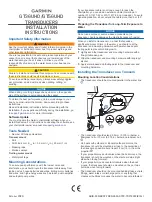
©Kanga Products 2001 – 2016 All rights reserved www.kanga-products.co.uk
The Kanga Products FOXX-3 20m QRP Transceiver
Assembly Instructions
Stage 1: The audio amplifier
The FOXX-3 audio amplifier is an LM386 integrated circuit, IC1. It has two inputs with separate volume controls, one
for the receiver audio and on for the transmitter sidetone. During transmission a transistor mutes the receiver audio
input. The amplifier’s output drives low power impedance mono or stereo headphones via a 3.5mm jack socket. The
headphones used with personal stereo players are suitable. If a mono jack is used, a small track cut is necessary to
prevent audio signal being short-circuited to ground. See diagram on the following page. Alternatively a 2 pin header
plug and socket (supplied) can be fitted instead of the jack socket.
Referring to the diagrams on the following page, fit and solder the audio amplifier components in the positions
marked on the component side of the board. The electrolytic capacitors C1, C3, C6 and C9 have a negative and a
positive lead and must be connected the correct way round otherwise they may be damaged when power is applied.
The negative lead is shorter as supplied and is marked with a minus (-) sign on the body of the capacitor. This lead
goes through the hole marked with a minus sign and is soldered to the square pad.
Part
Type
Markings
Notes
R1
100Ω
Brown, Black, Brown, Gold
R2
10KΩ
Brown, black, Orange, Gold
R3
10Ω
Brown, Black, Black, Gold
VR1
47KΩ
47K
Gently push the spindles into the
VR2
1KΩ
1K
central holes of these after soldering.
IC Socket
Fit in position marked IC1 with notch
towards lower edge of the board.
C1
100µF
100µF 16v
Electrolytic capacitor - observe polarity
C2
100nF
104
C3
100µF
100µF 16v
Electrolytic capacitor - observe polarity
C4
100nF
104
C5
100nF
104
C6
10µF
10µF 16v
Electrolytic capacitor - observe polarity
C7
100nF
104
C8
10nF
103
C9
100µF
100µF 16v
Electrolytic capacitor - observe polarity
C10
100nF
104
CON1
2-pin plug
Fit with plastic tab near edge of board
CON2
3.5mm Jack socket or 2-pin plug
Use the connector you prefer
IC1
LM386
LM386
Fit into IC socket with notch
towards lower edge of board.
It is important to fit CON1 as shown otherwise the power supply connections will be reversed.































